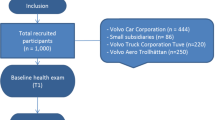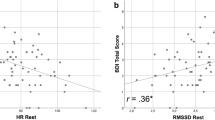Abstract
This study investigated the relationship between two dimensions of anger-hostility-the expression of anger-hostility and the experience of anger-hostility-and cardiovascular reactivity in provoked and angered men. A serial subtraction task was administered to 41 male undergraduates who were provoked and angered. A measure of the expression of anger-hostility correlated positively and significantly with systolic and diastolic blood pressure (BP) reactivity. There were no significant correlations between a measure of the experience of anger-hostility and cardiovascular reactivity. The two types of anger-hostility were also found to relate differentially to life-style variables that have been identified as risk factors for coronary heart disease (CHD), with only the expression of anger-hostility showing positive relationships with these life-style CHD risk factors. These findings are discussed within the context of a similar differential relationship between the two dimensions of anger-hostility and CAD and CHD. Finally, significant negative relationships were obtained between the experience of anger-hostility and resting BP and heart rate levels. These findings are discussed within the context of other data suggesting that trait anxiety-neuroticism may have protective properties.
Similar content being viewed by others
References
Baggio, M. K., Supplee, K., and Curtis, N. (1981). Reliability and validity of four anger scales.J. Personal. Assess. 45: 639–648.
Barefoot, J. L., Williams, R. B., and Dahlstrom, W. G. (1983). Hostility, CHD incidence and total mortality: A 25-year follow-up study of 255 physicians.Psychosom. Med. 45: 59–63.
Bendig, A. W. (1962). Factor analytic scales of covert and overt hostility.J. Consult. Psychol. 26, 200.
Blumenthal, J. A., Thompson, L. W., Williams, R. S., and Kong, Y. (1979). Anxiety-proneness and coronary heart disease.J. Psychosom. Res. 23: 17–21.
Buss, A. H., and Durkee, A. (1957). An inventory for assessing different kinds of hostility.J. Consult. Psychol. 21: 343–349.
Cook, W., and Medley, D. (1954). Proposed hostility for Pharisaic-virtue skills of the MMPI.J. Appl. Psychol. 38: 414–418.
Davies, M. (1970). Blood pressure and personality.J. Psychosom. Res. 14: 89–104.
Dembroski, T. M., and Costa, P. T. (1988). Assessment of coronary-prone behavior: A current overview.Ann. Behav. Med. 10: 60–63.
Dembroski, T. M., MacDougall, J. M., Shields, J. L., Petitto, J., and Lushene, R. (1978). Components of the Type A coronary-prone behavior pattern and cardiovascular responses to psychomotor performance challenge.J. Behav. Med. 1, 159–176.
Dembroski, T. M., MacDougall, J. M., Williams, R. B., Haney, T. L., and Blumenthal, J. A. (1985). Components of Type A, hostility, and anger-in: Relationship to angiographic findings.Psychosom. Med. 47: 219–233.
Dembroski, T. M., MacDougall, J. M., Costa, P. T., and Grandits, G. A. (1989). Components of hostility as predictors of sudden death and myocardial infarction in the Multiple Risk Factor Intervention Trial.Psychosom. Med. 51: 514–422.
Diamond, E. L., Schneiderman, N., Schwartz, D., Smith, J. C., Vorp, R., and Pasin, R. D. (1984). Harassment, hostility, and Type A as determinants of cardiovascular reactivity during competition.J. Behav. Med. 7: 171–187.
Edmunds, G., and Kendrick, D. C. (1980).The Measurement of Human Aggressiveness, Ellis Horwood, West Sussex, England.
Elias, M. F., Robbins, M. A., Rice, A., and Edgecomb, J. L. (1982). Symptom reporting, anxiety and depression in arteriographically classified middle-aged chest pain patients.Explor. Aging Res. 8: 45–81.
Engebretson, T. D., Matthews, K. A., and Scheier, M. F. (1989). Relations between anger expression and cardiovascular reactivity: Reconciling inconsistent findings through a matching hypothesis.J. Personal. Soc. Psychol. 57: 513–521.
Eysenck, H. J. (1983). Stress, disease and personality: The “inoculation effect.” In Cooper, C. L. (ed.),Stress Research, Wiley, New York, pp. 121–146.
Eysenck, H. J. (1984). Personality, stress and lung cancer. In Rachman, S. (ed.),Contributions to Medical Psychology, Vol. 3, Pergamon Press, Oxford, pp. 151–171.
Glass, C. D., Krakoff, L. R., Contrada, R. J.,el al. (1980). Effect of harassment and competition upon cardiovascular and plasma catecholamine responses in type A and B individuals.Psychophysiology 17: 453–463.
Glass, C. D., Lake, C. R., Contrada, R. J., Kehoe, K., and Erlanger, L. R. (1983). Stability of individual differences in physiological responses to stress.Health Psychol. 2: 317–341.
Goodman, M., and Dembroski, T. M. (1991).Exploration of a standardized method to obtain a stable baseline in psychophysiological studies. Paper presented at 12th annual scientific sessions of the Society of Behavioral Medicine, Washington, DC, March 21.
Harburg, E. (1962). Covert hostility: Its social origins and relationship to overt compliance. Unpublished doctoral dissertation, University of Michigan, Ann Arbor.
Hardy, J. H., and Smith, T. W. (1988). Cynical hostility and vulnerability to disease: Social support, life stress, and psychological response to conflict.Health Psychol. 7: 447–459.
Hearn, M. D., Murray, D. M., and Luyker, R. V. (1989). Hostility, coronary heart disease and total mortality: A 33-year follow-up study of university students.J. Behav. Med. 12: 105–121.
Hecker, H. L., Chesney, M. A., Black, G. W., and Frautschi, N. (1988). Coronary-prone behaviors in the Western Collaborative Group Study.Psychosom. Med. 50: 153–164.
Holroyd, K. A., and Gorkin, L. (1987). Young adults at risk for hypertension: Effects of family history and anger management in determining responses to interpersonal conflict.J. Psychosom. Res. 27: 131–138.
Jenkins, D. C. (1988). Epidemiology of cardiovascular diseases.J. Consult. Clin. Psychol. 56: 324–332.
MacDougall, J. M., Dembroski, T. M., and Krantz, D. S. (1981). Effects of type of challenge on pressor and heart rate responses in Type A and B women.Psychophysiology 18: 1–9.
MacDougall, J. M., Dembroski, T. M., Dimsdale, J. E., and Hackett, T. P. (1985). Components of Type A, Hostility, and anger-in: Relationship to angiographic findings.Psychosom. Med. 47: 219–233.
Musante, L., MacDougall, J. M., Dembroski, T. M., and Costa, P. T., Jr. (1989). Potential for hostility and dimensions of anger.Health Psychol. 8: 343–354.
Persky, H., Smith, K. D., and Basu, G. K. (1971). Relation of psychological measures of aggression and hostility to testosterone production in men.Psychosom. Med. 33: 265–277.
Rosenman, R. H. (1978). The interview method of assessment of the coronary-prone behavior pattern. In Dembroski, T. M., Weiss, S. M., Shields, J. L., Haynes, S. G., and Feinleib, M. (eds.),Coronary-Prone Behavior, Springer-Verlag, New York, pp. 55–70.
Sarason, I. (1961). Intercorrelations among measures of hostility.J. Clin. Psychol. 17: 192–195.
Shekelle, R. B., Hulley, S., Neaton, J., Billings, J., Buchani, N., Gerace, T., Jocobs, D., Lasser, N., Mittlemark, M., and Stamler, M., and Stamler, A. (1985). The MRFIT Research Group: The MRFIT Behavior Pattern Study. II. Type A behavior and the incidence of coronary heart disease.Am. J. Epidemiol. 122: 221–230.
Siegman, A. W., Dembroski, T. M., and Ringel, N. (1987). Components of hostility and the severity of coronary artery disease.Psychosom. Med. 49: 127–135.
Siegman, A. W., Dohm, F. A. and Gjesdal, J. (1988).The effects of repressive coping style on the relationship between hostility, neuroticism, and cardiovascular reactivity. Symposium paper presented at the annual meetings of the Society for Behavioral Medicine, Boston, April.
Siegman, A. W., and Anderson, R. A. (1990). Dimensions of hostility and CVR: The role of challenge.Psychosom. Med. 52: 235–236.
Siegman, A. W., Anderson, R., and Berger, T. (1990). The angry voice: Its effects on the experience of anger and cardiovascular reactivity.Psychosom. Med. 52: 631–643.
Siegman, A. W., Anderson, R. A., Jr., and Boyle, S. (1991).Repression, impression management, trait anxiety and cardiovascular reactivity. Paper read at the annual meetings of the Society for Behavioral Medicine, Washington, DC, March.
Siegman, A. W., Lating, J., Johnston, G. S., and Boyle, S. (1992).Structured interview derived hostility scores and thallium stress test results in men and women. Presented at the annual meetings of the American Psychosomatic Society, New York City, April.
Smith, M. A., and Houston, B. K. (1987). Hostility, anger expression, cardiovascular respon-sivity, and social support.Bio. Psychol. 24: 39–48.
Steiger, J. H. (1980). Tests for comparing elements of a correlation matrix.Psychol. Bull. 87: 245–251.
Suarez, E. C., and Williams, R. B. (1989). Situational determinants of cardiovascular and emotional responses in high and low hostile men.Psychosom. Med. 51: 404–418.
Watson, D., and Pennebaker, J. W. (1989). Health complaints, stress, and distress. Exploring the central role of negative affectivity.Psychol. Rev. 96: 239–254.
Williams, R. B., Jr. (1989). Biological mechanisms mediating the relationship between behavior and coronary heart disease. In Siegman, A. W. and Dembroski, T. M. (eds.),In Search of Coronary Prone Behavior: Beyond Type A, Lawrence Erlbaum, Hillsdale, NJ.
Williams, R. B., Haney, T. L., Lee, K. L., Y., Kong, Blumenthal, J., and Whalen, R. (1980). Type A behavior, hostility, and coronary atherosclerosis.Psychosom. Med. 42: 539–549.
Author information
Authors and Affiliations
Additional information
The research reported in this paper was supported in part by Research Grant HL-36027 from the National Heart, Lung, and Blood Institute.
Rights and permissions
About this article
Cite this article
Siegman, A.W., Anderson, R., Herbst, J. et al. Dimensions of anger-hostility and cardiovascular reactivity in provoked and angered men. J Behav Med 15, 257–272 (1992). https://doi.org/10.1007/BF00845355
Accepted:
Issue Date:
DOI: https://doi.org/10.1007/BF00845355




